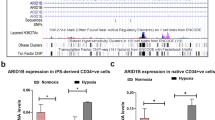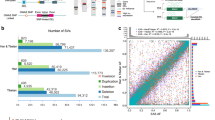Abstract
Tibetans do not exhibit increased hemoglobin concentration at high altitude. We describe a high-frequency missense mutation in the EGLN1 gene, which encodes prolyl hydroxylase 2 (PHD2), that contributes to this adaptive response. We show that a variant in EGLN1, c.[12C>G; 380G>C], contributes functionally to the Tibetan high-altitude phenotype. PHD2 triggers the degradation of hypoxia-inducible factors (HIFs), which mediate many physiological responses to hypoxia, including erythropoiesis. The PHD2 p.[Asp4Glu; Cys127Ser] variant exhibits a lower Km value for oxygen, suggesting that it promotes increased HIF degradation under hypoxic conditions. Whereas hypoxia stimulates the proliferation of wild-type erythroid progenitors, the proliferation of progenitors with the c.[12C>G; 380G>C] mutation in EGLN1 is significantly impaired under hypoxic culture conditions. We show that the c.[12C>G; 380G>C] mutation originated ∼8,000 years ago on the same haplotype previously associated with adaptation to high altitude. The c.[12C>G; 380G>C] mutation abrogates hypoxia-induced and HIF-mediated augmentation of erythropoiesis, which provides a molecular mechanism for the observed protection of Tibetans from polycythemia at high altitude.
This is a preview of subscription content, access via your institution
Access options
Subscribe to this journal
Receive 12 print issues and online access
$209.00 per year
only $17.42 per issue
Buy this article
- Purchase on Springer Link
- Instant access to full article PDF
Prices may be subject to local taxes which are calculated during checkout




Similar content being viewed by others

References
Beall, C.M. Two routes to functional adaptation: Tibetan and Andean high-altitude natives. Proc. Natl. Acad. Sci. USA 104 (suppl. 1), 8655–8660 (2007).
Prchal, J.T. Production of Erythrocytes (McGraw Hill, New York, 2010).
Prchal, J.T. in Secondary Polycythemia (Erythrocytosis) 823–839 (McGraw Hill, New York, 2010).
Simonson, T.S. et al. Genetic evidence for high-altitude adaptation in Tibet. Science 329, 72–75 (2010).
Beall, C.M. et al. Natural selection on EPAS1 (HIF2α) associated with low hemoglobin concentration in Tibetan highlanders. Proc. Natl. Acad. Sci. USA 107, 11459–11464 (2010).
Yi, X. et al. Sequencing of 50 human exomes reveals adaptation to high altitude. Science 329, 75–78 (2010).
Lorenzo, F.R. et al. Novel PHD2 mutation associated with Tibetan genetic adaptation to high altitude hypoxia. ASH 52nd Annual Meeting (ASH, Orlando, FL, 2010).
Tian, H., McKnight, S.L. & Russell, D.W. Endothelial PAS domain protein 1 (EPAS1), a transcription factor selectively expressed in endothelial cells. Genes Dev. 11, 72–82 (1997).
Wang, G.L. & Semenza, G.L. Characterization of hypoxia-inducible factor 1 and regulation of DNA binding activity by hypoxia. J. Biol. Chem. 268, 21513–21518 (1993).
Prabhakar, N.R. & Semenza, G.L. Adaptive and maladaptive cardiorespiratory responses to continuous and intermittent hypoxia mediated by hypoxia-inducible factors 1 and 2. Physiol. Rev. 92, 967–1003 (2012).
Wang, G.L. & Semenza, G.L. General involvement of hypoxia-inducible factor 1 in transcriptional response to hypoxia. Proc. Natl. Acad. Sci. USA 90, 4304–4308 (1993).
Kapitsinou, P.P. et al. Hepatic HIF-2 regulates erythropoietic responses to hypoxia in renal anemia. Blood 116, 3039–3048 (2010).
Yoon, D., Ponka, P. & Prchal, J.T. Hypoxia. 5. Hypoxia and hematopoiesis. Am. J. Physiol. Cell Physiol. 300, C1215–C1222 (2011).
Yoon, D. et al. Hypoxia-inducible factor-1 deficiency results in dysregulated erythropoiesis signaling and iron homeostasis in mouse development. J. Biol. Chem. 281, 25703–25711 (2006).
Pineda Torra, I., Jamshidi, Y., Flavell, D.M., Fruchart, J.C. & Staels, B. Characterization of the human PPARα promoter: identification of a functional nuclear receptor response element. Mol. Endocrinol. 16, 1013–1028 (2002).
Xing, J. et al. Genomic analysis of natural selection and phenotypic variation in high-altitude mongolians. PLoS Genet. 9, e1003634 (2013).
Huff, C.D. et al. Crohn's disease and genetic hitchhiking at IBD5. Mol. Biol. Evol. 29, 101–111 (2012).
Hirsilä, M., Koivunen, P., Gunzler, V., Kivirikko, K.I. & Myllyharju, J. Characterization of the human prolyl 4-hydroxylases that modify the hypoxia-inducible factor. J. Biol. Chem. 278, 30772–30780 (2003).
Ang, S.O. et al. Disruption of oxygen homeostasis underlies congenital Chuvash polycythemia. Nat. Genet. 32, 614–621 (2002).
Loeffler, M., Herkenrath, P., Wichmann, H.E., Lord, B.I. & Murphy, M.J. Jr. The kinetics of hematopoietic stem cells during and after hypoxia. A model analysis. Blut 49, 427–439 (1984).
Cipolleschi, M.G. et al. Severe hypoxia enhances the formation of erythroid bursts from human cord blood cells and the maintenance of BFU-E in vitro. Exp. Hematol. 25, 1187–1194 (1997).
Drmanac, R. et al. Human genome sequencing using unchained base reads on self-assembling DNA nanoarrays. Science 327, 78–81 (2010).
Bigham, A.W. et al. Identifying positive selection candidate loci for high-altitude adaptation in Andean populations. Hum. Genomics 4, 79–90 (2009).
Albiero, E. et al. Isolated erythrocytosis: study of 67 patients and identification of three novel germ-line mutations in the prolyl hydroxylase domain protein 2 (PHD2) gene. Haematologica 97, 123–127 (2012).
Albiero, E. et al. Analysis of the oxygen sensing pathway genes in familial chronic myeloproliferative neoplasms and identification of a novel EGLN1 germ-line mutation. Br. J. Haematol. 153, 405–408 (2011).
Ladroue, C. et al. Distinct deregulation of the hypoxia inducible factor by PHD2 mutants identified in germline DNA of patients with polycythemia. Haematologica 97, 9–14 (2012).
Percy, M.J. et al. Two new mutations in the HIF2A gene associated with erythrocytosis. Am. J. Hematol. 87, 439–442 (2012).
Percy, M.J. et al. A family with erythrocytosis establishes a role for prolyl hydroxylase domain protein 2 in oxygen homeostasis. Proc. Natl. Acad. Sci. USA 103, 654–659 (2006).
Aggarwal, S. et al. EGLN1 involvement in high-altitude adaptation revealed through genetic analysis of extreme constitution types defined in Ayurveda. Proc. Natl. Acad. Sci. USA 107, 18961–18966 (2010).
Ang, S.O. et al. Endemic polycythemia in Russia: mutation in the VHL gene. Blood Cells Mol. Dis. 28, 57–62 (2002).
Percy, M.J. et al. A novel erythrocytosis-associated PHD2 mutation suggests the location of a HIF binding groove. Blood 110, 2193–2196 (2007).
Percy, M.J. Familial erythrocytosis arising from a gain-of-function mutation in the HIF2A gene of the oxygen sensing pathway. Ulster Med. J. 77, 86–88 (2008).
Simonson, T.S., McClain, D.A., Jorde, L.B. & Prchal, J.T. Genetic determinants of Tibetan high-altitude adaptation. Hum. Genet. 131, 527–533 (2012).
Ge, R.L. et al. Metabolic insight into mechanisms of high-altitude adaptation in Tibetans. Mol. Genet. Metab. 106, 244–247 (2012).
Xing, J. et al. Toward a more uniform sampling of human genetic diversity: a survey of worldwide populations by high-density genotyping. Genomics 96, 199–210 (2010).
Xing, J. et al. Fine-scaled human genetic structure revealed by SNP microarrays. Genome Res. 19, 815–825 (2009).
Huff, C.D. et al. Maximum-likelihood estimation of recent shared ancestry (ERSA). Genome Res. 21, 768–774 (2011).
Browning, S.R. & Browning, B.L. Rapid and accurate haplotype phasing and missing-data inference for whole-genome association studies by use of localized haplotype clustering. Am. J. Hum. Genet. 81, 1084–1097 (2007).
Goldstein, D.B. & Schlotterer, C. in Microsatellites: Evolution and Applications; Estimating the Age of Mutations Using Variation at Linked Markers 368 (Oxford University Press, Oxford, 1999).
Hirsilä, M. et al. Effect of desferrioxamine and metals on the hydroxylases in the oxygen sensing pathway. FASEB J. 19, 1308–1310 (2005).
Koivunen, P., Hirsila, M., Kivirikko, K.I. & Myllyharju, J. The length of peptide substrates has a marked effect on hydroxylation by the hypoxia-inducible factor prolyl 4-hydroxylases. J. Biol. Chem. 281, 28712–28720 (2006).
Swierczek, S.I. et al. Methylation of AR locus does not always reflect X chromosome inactivation state. Blood 119, e100–e109 (2012).
Acknowledgements
P.K. is supported by Academy of Finland grants 120156, 140765 and 218129, the S. Juselius Foundation, the Finnish Cultural Foundation and the Finnish Cancer Organizations. B.O. is supported by US National Institutes of Health (NIH) Mentored Career Development Award HL119355-01. J.X. is supported by the National Human Genome Research Institute (HG005846). G.R.-L. is supported by the National Basic Research Program of China (grant 2012CB518200) and by the Program of International Science and Technology Cooperation of China (grant 2011DFA32720). S.S. is supported by US NIH grant P01CA108671. T.S.S. is supported by the US NIH T32 Postdoctoral Fellowship HL098062. L.B.J. is supported by the University of Utah Seed Grant Program for studies of hypoxic adaptation. G.L.S. is supported by the Johns Hopkins Institute for Cell Engineering. J.T.P. is supported by US NIH grant P01CA108671, a Veterans Affairs Merit Review Award and the University of Utah Seed Grant Program for studies of hypoxic adaptation.
Author information
Authors and Affiliations
Contributions
F.R.L. screened and discovered the PHD2 alteration, designed the experiment, performed expression studies and data analysis, and drafted and edited the manuscript. M.M. and P.K. performed the kinetic studies and wrote and edited the manuscript. C.H., J.X., T.S.S. and L.B.J. analyzed array data, characterized and estimated the origin of the variants and edited the manuscript. P.A.K. and G.R.-L. hosted F.R.L., T.T. and J.T.P. in their countries, assisted with the recruitment of subjects in India and China, and obtained necessary local regulatory and institutional review board documents. T.W. helped organize and assisted with the collection and phenotyping of samples from the Tibetan plateau. P.G. helped organize collection and assisted in the preparation and extraction of DNA in India. S.S. performed the erythroid colony assays, interpreted their results and edited the manuscript. M.E.S. performed the quantification of mean size and hemoglobinization of BFU-Es. A.W. designed and performed the statistical analysis of changes in BFU-E hypersensitivity to EPO. V.G. and D.A.M. critically revised the concept, contributed to the intellectual content and design, and gave final approval of the manuscript. G.L.S. critically revised the concept, contributed to the intellectual content and wrote the manuscript. B.O., W.G.K., E.L. and T.M.K. performed the knockdown study and edited the manuscript. J.T.P. conceived and designed the study, analyzed the data, and wrote and edited the manuscript.
Corresponding author
Ethics declarations
Competing interests
The authors declare no competing financial interests.
Integrated supplementary information
Supplementary Figure 1 Genetic relationship between local Tibetans and other East Asian populations.
(A) Principal-components analysis. The first two principal components (PCs) are shown. Each individual is represented by one dot, and color corresponds to the population. The percentage of variance explained by each PC is shown on the axis. (b) Individual grouping inferred by ADMIXTURE. Results from k = 4 are shown. Each individual’s genome is represented by a vertical bar composed of colored sections, where each section represents the proportion of an individual’s ancestry derived from one of the k ancestral populations. Individuals are arrayed horizontally and grouped by population as indicated. JPT, Japanese; CHB, Chinese; Local Tibetan, Tibetans collected in this study. The two Local Tibetans who have the wild-type D4E variant (TU09 and TU12) are indicated in the plots.
Supplementary Figure 2 Analysis of purified wild-type PHD2 enzyme, the D4E and C127S single mutants, and the D4E and C127S double mutant.
Recombinant enzymes were expressed in insect cells and were affinity purified exploiting their C-terminal Flag tags in anti-Flag affinity gel columns. The near-to-homogeneity purified enzymes were analyzed by 10% SDS-PAGE followed by Coomassie Blue staining. Molecular weight markers (kDa) are shown on the left.
Supplementary Figure 3 Expression study of hypoxia and several HIF target genes.
(a) Expression of hypoxia-regulated genes in granulocytes from Tibetan (n = 4) versus control (n = 6) subjects. (b) BFU-E expression of selected HIF target genes in Tibetan (n = 1) versus control (n = 2) erythroid progenitors grown at optimal EPO levels (3,000 mU). Two independent experiments (technical replicates) from BFU-Es were pooled together and utilized the statistical randomization test using the Relative Expression Software Tool (REST, Qiagen). Error bars represent s.d.
Supplementary information
Supplementary Text and Figures
Supplementary Figures 1–3, Supplementary Tables 1–5 and Supplementary Note. (PDF 1555 kb)
Rights and permissions
About this article
Cite this article
Lorenzo, F., Huff, C., Myllymäki, M. et al. A genetic mechanism for Tibetan high-altitude adaptation. Nat Genet 46, 951–956 (2014). https://doi.org/10.1038/ng.3067
Received:
Accepted:
Published:
Issue Date:
DOI: https://doi.org/10.1038/ng.3067
This article is cited by
-
Secondary polycythaemia from chronic hypoxia is a risk for cerebral thrombosis: a case report
BMC Neurology (2023)
-
Hypoxia induces alterations in tRNA modifications involved in translational control
BMC Biology (2023)
-
Zebrafish ELL-associated factors Eaf1/2 modulate erythropoiesis via regulating gata1a expression and WNT signaling to facilitate hypoxia tolerance
Cell Regeneration (2023)
-
Human adaptation to high altitude: a review of convergence between genomic and proteomic signatures
Human Genomics (2022)
-
The genetics of human performance
Nature Reviews Genetics (2022)


